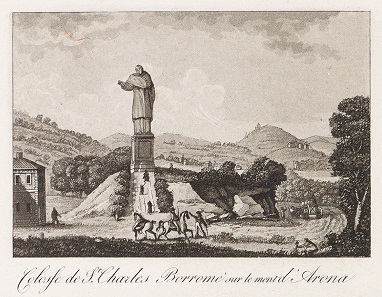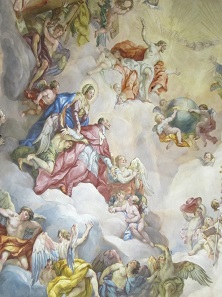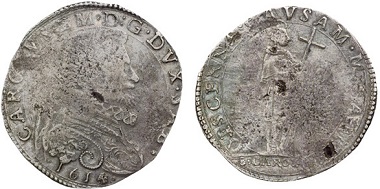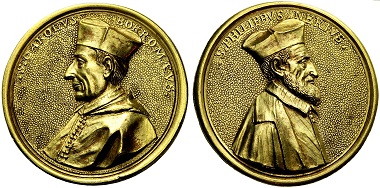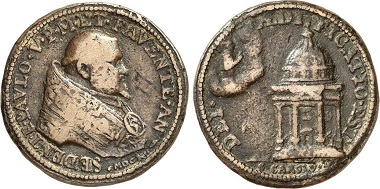translated by Annika Backe
In addition to the founder of the Jesuits, Ignatius of Loyola, Saint Charles Borromeo is probably the saint mentioned most often with regards to the exemplary implementation of the church reform after the Council of Trent. Here we tell his story as mirrored in the numismatic testimonies.
Statue of St. Charles Borromeo in Arona, by Gabriel Lory (1784-1846). Swiss National Library, GS-GUGE-LORY-A-12.
A useful saint
On November 3, 1584, Charles Borromeo died. The various parties immediately started to exploit his name. The Pope praised him for his loyalty to the Holy See. The bishops considered him a champion of the church reform. The people remembered him as an irrepressible pastor. And the Borromeo family further promoted the memory of him. Many of them and their relatives had risen in the churchly hierarchy – a sufficient number to pursue the canonization of a Borromeo.
Charle’s cousin, Federico Borromeo who succeeded him as Archbishop of Milan in 1595, did everything to honor his memory. North of Arona, he had a 23 m high colossal statue of Charles Borromeo erected on a 14 m high base made of granite. Upon its 1697 completion, it was the world’s largest statue that was accessible on the inside. It had to relinquish this title in 1886, to the Statue of Liberty. So it didn’t come as a big surprise that Charles was canonized as early as 1610.
Ceiling fresco of St. Charles Church in Vienna. It features St. Charles Borromeo in the middle, clad in the cardinal attire. Behind him Virgin Mary interceding for him, to her son, God the Father and the Holy Spirit. Photo: UK.
The saints of the Counter-Reformation
In 1588 the Congregation of Rites was erected. One of its functions was the process of canonization of Catholic saints. The new papacy didn’t trust the cult of saints as practiced by the ordinary people.
Rome wanted to centrally control not only the liturgy and doctrine, but also to whom the ordinary people prayed. Who was raised to the altars in the era of the Counter-Reformation is thus an interesting testimony of how the Church portrayed itself.
Charles Emanuel I of Savoy (1580-1630). 9 fiorini 1614, Turin. Rv. St. Charles Borromeo. – Charles Emanuel had coins minted in honor of St. Charles Borromeo to whom he got acquainted when the Archbishop traveled to Turin. From Astarte sale 22 (2010), 414.
Charles Borromeo was the first of the new saints.
1680 medal by Giuseppe Vismara on Charles Borromeo and Philipp Neri. From NAC sale 53 (2009), 669.
Philipp Neri was the other great reformer who was canonized on March 12, 1622, in a second canonization, together with Ignatius of Loyola, Franz Xaver, Theresa of Avila, and Isidore of Seville. His contemporaries were in absolute agreement about his achievements. And so the following joke about this joint canonization became popular: Gregor XV had raised four Spaniards and a Saint to the honor of the altars.
While he was still familiar to Goethe as his favorite saint, this representative of the Counter-Reformation is largely unknown to us nowadays. Neri took care of the pilgrims to Rome and popularized the pilgrimage to the seven Roman pilgrim churches. As a favorite popular saint and protagonist of many anecdotes, the ‘Apostle of Rome’ and founder of the Congregation of the Oratory evolved into the human version of a priest of the Counter-Reformation. All in all, between 1540 and 1770, 27 men and 5 women were canonized. The majority of them came from Italy (18) and Spain (14). Every one of them belonged to the clergy, and most (19) were members of the new Order.
Personification of Faith (with chalice and paten), banishing evil to hell. Where Charles Borromeo is, the victory over the evil Counter-Reformation isn’t far. Also, an angel sets the unholy books on fire with a torch. Photo: UK.
It was particularly the founders of the reformed orders and their assistants as well as the reformers of the established orders who were canonized. Plus, of course, a few missionaries, who proclaimed the Word of Christ to distant peoples on behalf of the new orders. Not to forget the mystics of both sexes.
Martyrs and helpers of the poor, in contrast, weren’t needed among the new saints. There were enough of them as it was. In Rome and many other cities, the catacombs were discovered as an inexhaustible source of relics through interpreting the skeletons found within as the remains of the Christians who had been persecuted in the Roman Empire.
Allying with them, the saints of the Reformation would not only wait for resurrection, but join the living Catholics in their fight against Protestants, Reformed and Calvinists. Such was papal propaganda.
Paul V, 1605-1621. Bronze medal 1612. Rv. Charles Borromeo sitting on clouds, blessing San Carlo Church in Rome erected in his honor. From the Jaggi Coll., Gorny & Mosch sale 226 (2014), No. 3428.
A pious man
This is how the papal nephew and lateral thinker Charles Borromeo, who was certainly considered troublesome and unpleasant by many of his contemporaries, turned into the pious man of the hagiographies who had no doubts in the pursuit of his goal.
The first two parts can be found in our archive section: Part 1 and Part 2.




